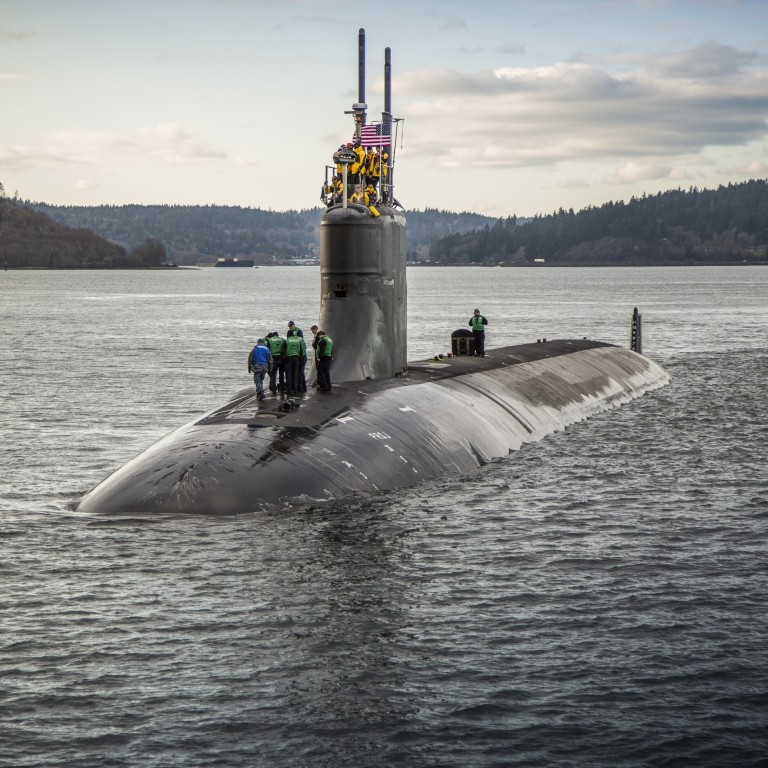
US nuclear submarine accident sparks safety fears in South China Sea
- Busy waterway’s complex underwater terrain and shipping litter make it a challenging environment for the giant vessels
- Collision has also highlighted the difficulties in safely disposing of the reactors from decommissioned subs, with no agreed guidelines, experts say
Defence experts have warned that nuclear submarines – among the world’s deadliest weapons – are also vulnerable in the event of an underwater accident causing a nuclear leak, regardless of whether they are general-purpose attack subs (SSN) or platforms for the launch of ballistic missiles (SSBN).

03:10
US submarine strikes unknown underwater object in disputed South China Sea
“Possessing nuclear subs may represent a country’s defensive and offensive capabilities, but a lack of mandatory rules to push all countries to stick to them is still a big problem,” Beijing-based naval expert Li Jie said.
“None of the countries in the world – even superpowers like the United States, Russia, China and some experienced and developed Western countries – have come up with operational guidelines for their peers to follow when they need to solve problems in the aftermath of accidents involving nuclear subs.”
According to a US Navy report released on Sunday, the USS Connecticut – a Seawolf class SSN – collided with an unknown object in the South China Sea on October 2, injuring 11 sailors on board. The report said the submarine’s nuclear propulsion system was not affected and it was able to return to the Guam naval base for follow-up checks.
The accident was not announced until six days after the collision and no further details were provided, including the extent of the damage, what kind of object the sub had collided with, or the specific location of the accident.
The US Navy report said an assessment and preliminary repairs to the damaged sub were under way and two investigations would also be undertaken.
After submarine collision, China calls US voyages ‘major risk to peace’
Despite its sophisticated maritime detection systems, experts said the changeable and complex underwater terrain of the South China Sea was a challenging environment for the giant submarine, which measures more than 107 metres (351 feet) and has an underwater displacement of more than 9,000 tonnes.
“Nuclear subs are usually larger than conventional ones, hence it is more challenging for them in tighter littoral confines,” said Collin Koh, a maritime security analyst at Singapore’s S. Rajaratnam School of International Studies. “The general risks apply across the board for all subs, except that nuclear subs also carry a radiation safety risk.”
As one of the world’s busiest waterways for commercial vessels and fishing boats, as well as warships, the South China Sea is also littered with sunken ships and containers.
“We have multiple collision risks, from the complex undersea terrain – such asuncharted sea mountains – to inanimate objects such as shipwrecks, abandoned containers, and other bulky items that can be discarded at sea,” Koh said.
Zhou Chenming, a researcher from the Yuan Wang military science and technology institute in Beijing, said the possible leak of radiation waste from the USS Connecticut was the top concern for countries in the region.
“It’s still possible that radiation waste could have leaked from the sub’s pipelines during the collision, which appears to have been quite severe, as it caused injuries to nearly one dozen sailors. The reluctance of the US side to disclose more details will only stir up more speculation,” he said.
Both Zhou and Li said the collision had reminded the region of the increasing risks and costs of nuclear submarines.
The accident has also highlighted the cost of dismantling a nuclear submarine, which one Chinese military insider – who asked for anonymity because of the subject’s sensitivity – said amounted to the same as building a new one.
“In China, when the central government budgets 10 billion yuan (US$1.5 billion) to build a new SSN, another 10 billion yuan is also prepared for its decommissioning cost. Both China and the US dismantle the reactors from the hull, then use chemicals and cement to seal the radiation components, finding somewhere to store them. It is costly and needs more technology,” the insider said.
Is Southeast Asia waking up to need for unity in South China Sea?
The Soviet K-27 was scuttled in the Kara Sea, off the northeastern coast of Novaya Zemlya, in 1981 at a depth of just 30 metres (99 feet), after a nuclear leak killed nine of its crew.
“Like the former Soviet Union and today’s Russia, many other countries haven’t properly handled scrapped nuclear sub hulls, they just let them berth in their ports,” Li said.
“As more nuke subs reach decommissioning age and are replaced with new subs, more old hulls with nuclear reactors are being abandoned.”
The underwater arms race: China, Aukus and a deepening sub rivalry
The growing number of nuclear submarines in the region and ongoing changes in the undersea terrain suggest the costs of operating the vessels are also increasing, according to Li.
“Scientists have found more undersea volcanoes have woken up in the South China Sea in recent years, which has changed the underwater terrain, requiring constant contour mapping of the sea floor,” he said.
In July 2013, an oceanic research team of leading Taiwanese academics said it had discovered eight undersea volcanoes in the South China Sea within a radius of 10km (6 miles).
Wu Junfei, deputy director of Hong Kong’s Tianda Institute think tank, said the incident was “a good reminder to the US Navy that the South China Sea has complicated geographical conditions and heavy maritime traffic and, for their safety, they had better stay away in future”.
Additional reporting by William Zheng

